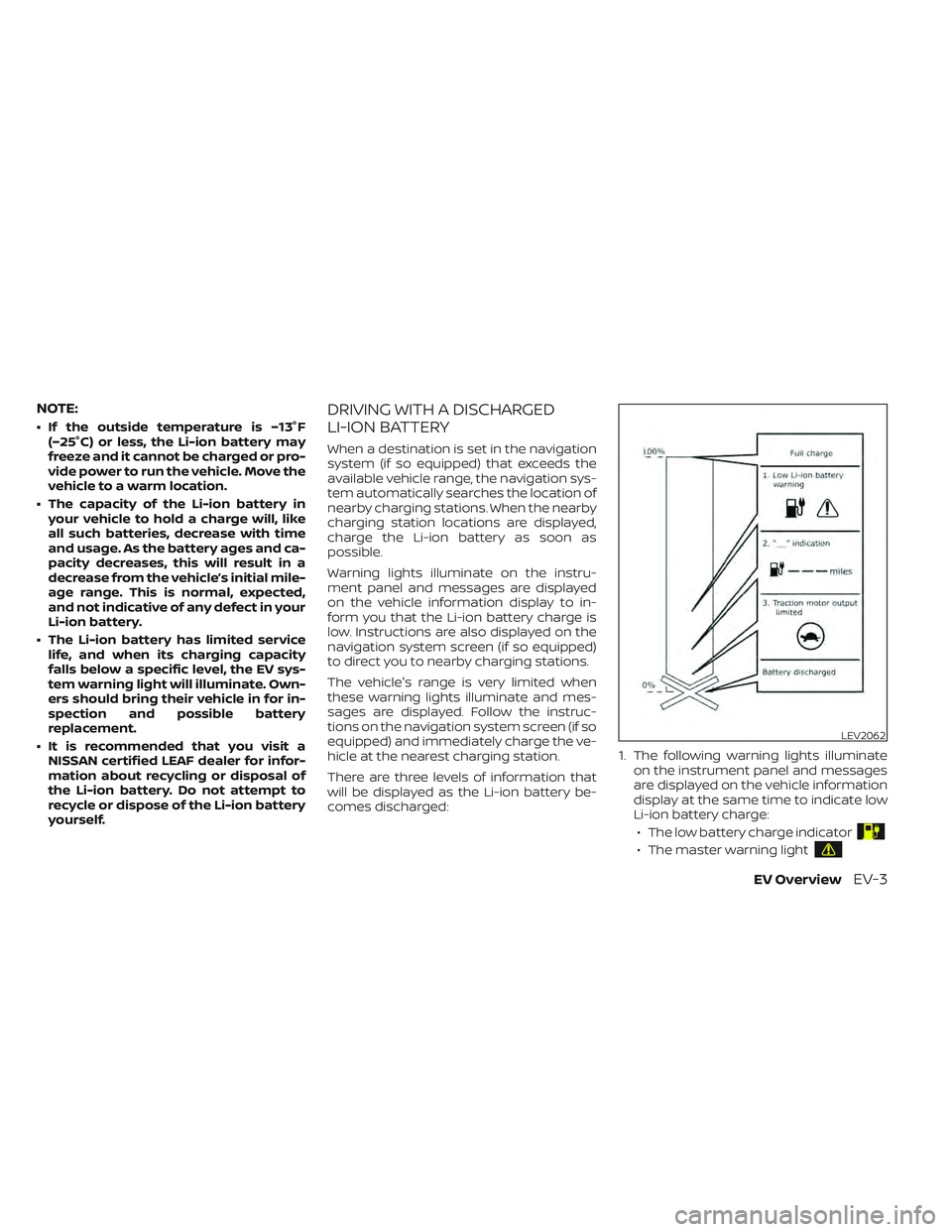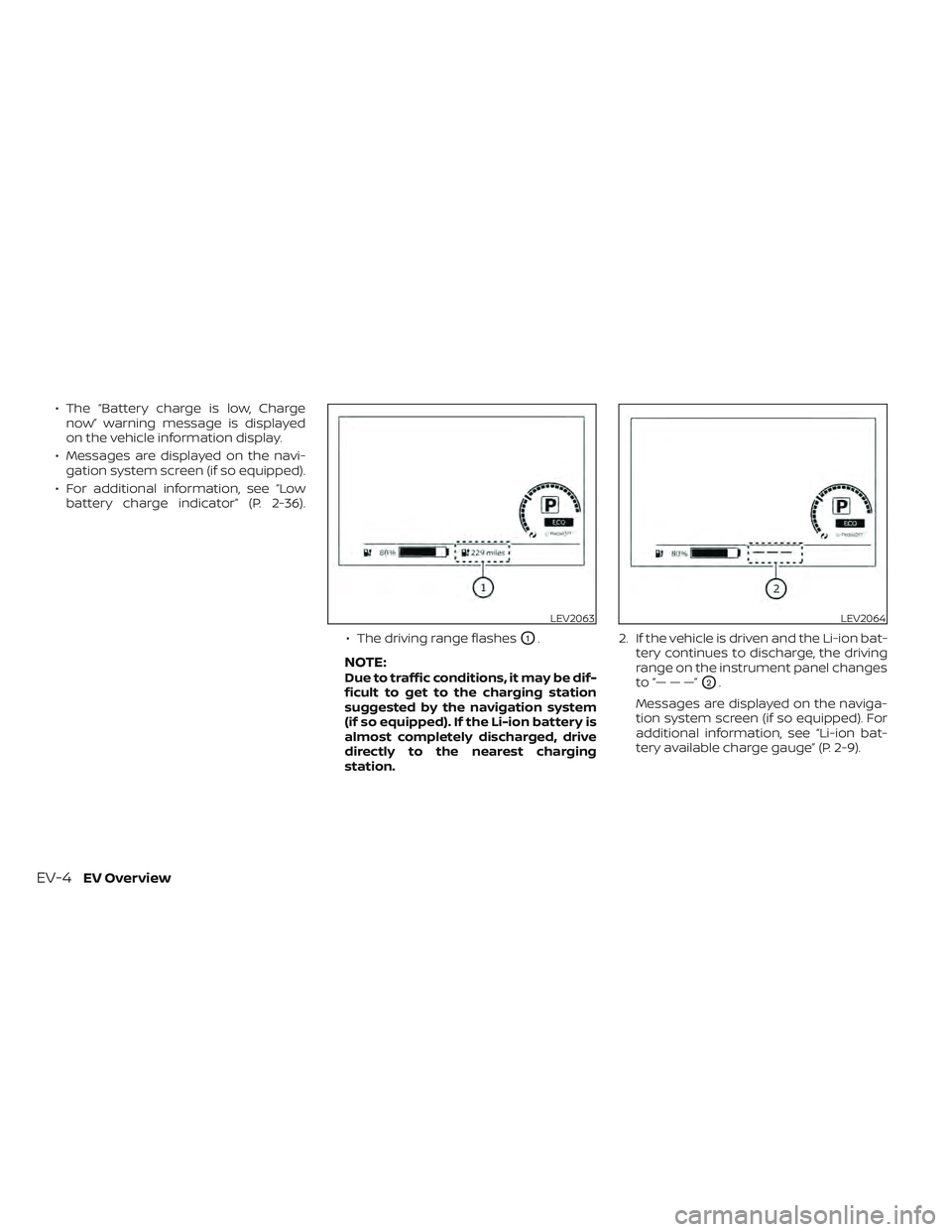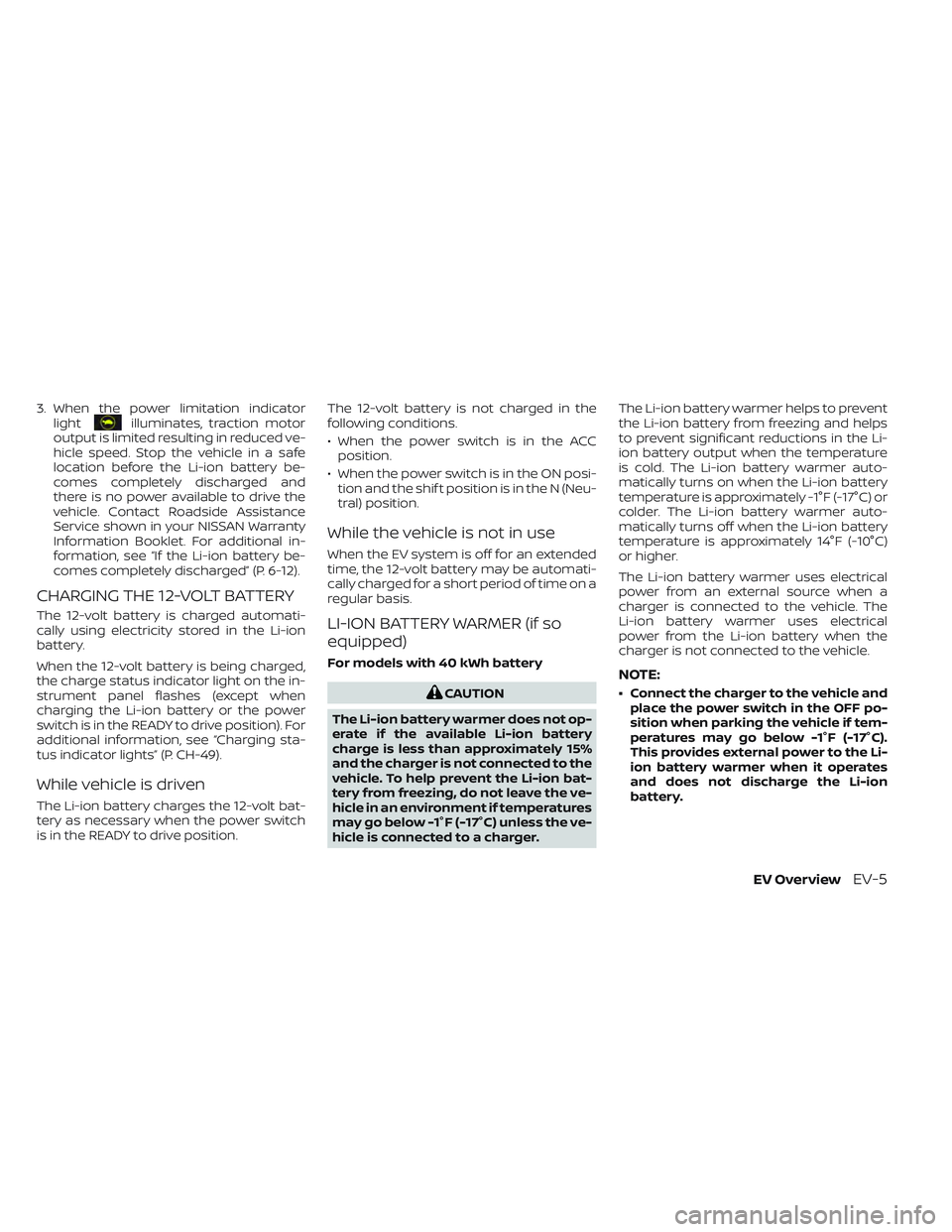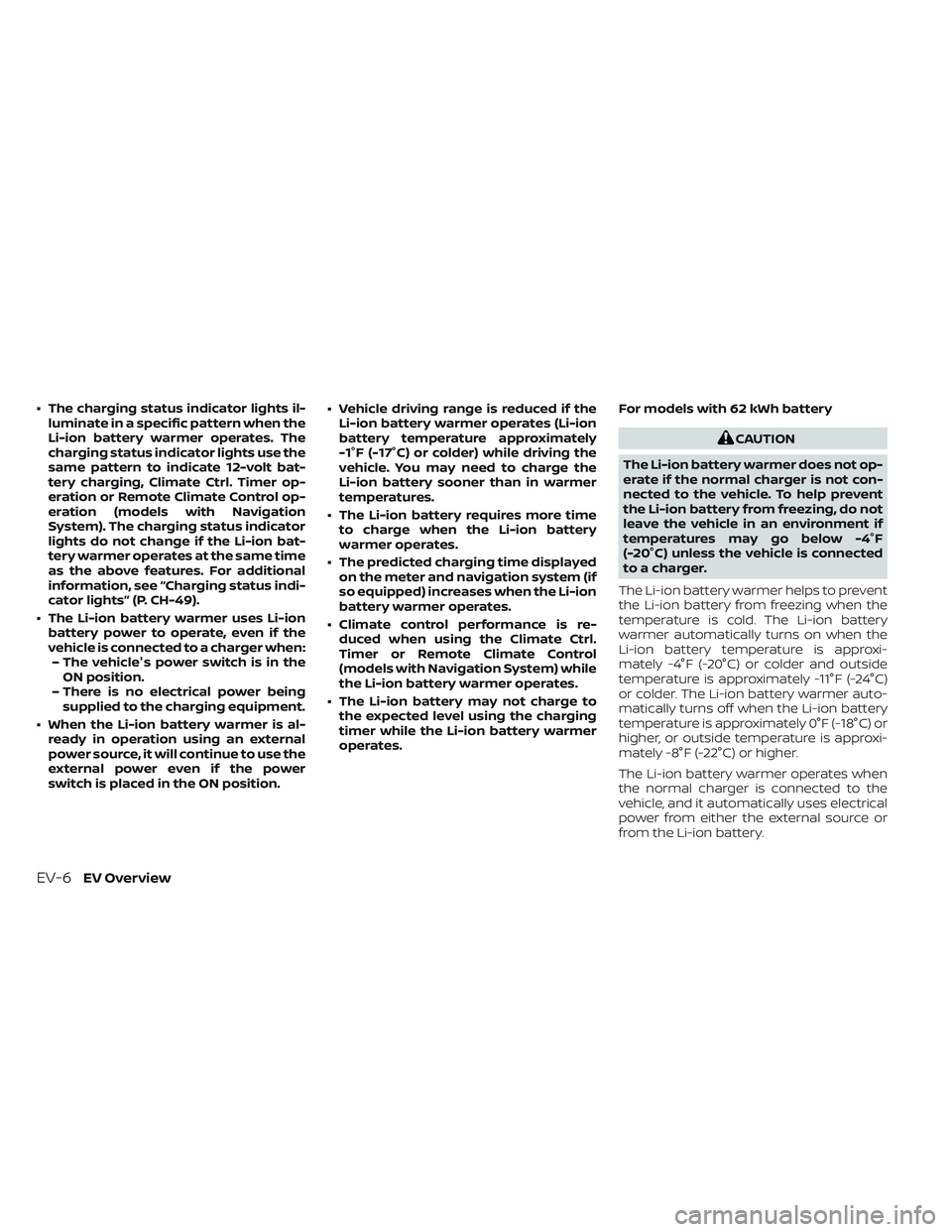charge NISSAN LEAF 2022 Owner´s Manual
[x] Cancel search | Manufacturer: NISSAN, Model Year: 2022, Model line: LEAF, Model: NISSAN LEAF 2022Pages: 618, PDF Size: 4.3 MB
Page 10 of 618

1. Charge port lid/Charging lid switch(P. 3-20, 2-58)
2. Hood (P. 3-18) 3. Wiper and washer switch/Switch
operation (P. 2-45)
Blade replacement (P. 8-12)
Windshield-washer fluid (P. 8-8) 4. Outside mirrors/Switch operation
(P. 3-25)
Side camera (if so equipped) (P. 4-11)
5. Power windows (P. 2-67)
6. Child safety rear door lock (P. 3-6)
7. Doors (P. 3-4) Keys (P. 3-2)
Door locks (P. 3-5)
NISSAN Intelligent Key® system (P. 3-6)
Security system (P. 2-42)
8. Wheels and tires (P. 8-25) Flat tire (P. 6-3)
Tire Pressure Monitoring System
(P. 5-4, 2-20, 6-3)
9. Headlight and turn signal lights/Switch
operation (P. 2-48)
Bulb replacement (P. 8-21)
LED Daytime Running Lights (DRL)
(if so equipped) (P. 2-53)
10. Fog lights/Switch operation
(if so equipped) (P. 2-55)
Bulb replacement (P. 8-21)
11. License plate installation (P. 10-10)
12. Front view camera (if so equipped)
(P. 4-11)
LIC3856
EXTERIOR FRONT
Illustrated table of contents0-3
Page 14 of 618

11. Lower instrument panel switches(P. 2-59)
Charge port lid switch (P. 3-20)
Immediate charge switch (P. 2-59)
Heated steering wheel switch
(if so equipped) (P. 2-57)
Steering Assist switch (if so equipped)
(P. 2-60)
Dynamic driver assistance switch
(if so equipped) (P. 2-59, 5-30, 5-45)
12. Fuse box cover (P. 8-15)
*For additional information, refer to the
NissanConnect® Manual
Illustrated table of contents0-7
Page 16 of 618

1. Vehicle information display (P. 2-26)Clock (P. 2-33)
Outside air temperature (P. 2-12) Li-ion battery available charge gauge
(P. 2-9)
Driving range (P. 2-8)
Odometer/twin trip odometer (P. 2-5)Indicator for timer (P. CH-43)
Power meter (P. 2-7)
2. Warning and indicator lights (P. 2-14) Turn signal/hazard indicator light
(P. 2-25)
READY to drive indicator light (P. 2-24)
ECO mode indicator (P. 2-13)
3. Speedometer (P. 2-5)
LIC3861
METERS AND GAUGES
Illustrated table of contents0-9
Page 18 of 618

Warning/Indicator
light (red) Name Page
12-volt battery
charge warning
light 2-15
orBrake warning
light
2-16
Electric shif t con-
trol system warn-
ing light 2-17
or
Electronic parking
brake indicator
light (if so
equipped)2-17
Warning/
Indicator
light (red) Name Page
Master warning
light
2-18
Seat belt warning
light2-18
Security indicator
light2-18
Supplemental air
bag warning light2-18
Warning/
Indicator light
(yellow) Name Page
orAnti-lock Braking
System (ABS)
warning light
2-19
Approaching
Vehicle Sound for
Pedestrians (VSP)
OFF system
warning light2-19
Automatic Emer-
gency Braking
(AEB) with Pedes-
trian Detection
system warning
light2-19
WARNING AND INDICATOR LIGHTS
Illustrated table of contents0-11
Page 22 of 618

EV Overview
The EV (Electric Vehicle) system................EV-2
Li-ion battery ................................... EV-2
Driving with a discharged Li-ion battery .....EV-3
Charging the 12-volt battery .................EV-5
Li-ion battery warmer (if so equipped) .......EV-5
High voltage precautions .......................EV-8
High-voltage components ..................EV-8
Road accident precautions .....................EV-9
Emergency shut-off system ................EV-10
EV characteristics ............................. EV-11
Noise and vibration ........................ EV-12
Life with an EV (scene guide) ..................EV-12
Charging the Li-ion battery .................EV-12
Before driving your vehicle
(models with Navigation System) ...........EV-14
Checking Li-ion battery charging
status ...................................... EV-15
Operating the climate control system
before driving .............................. EV-16Starting your vehicle
....................... EV-17
Driving the vehicle .......................... EV-18
Charging af ter driving .....................EV-22
Efficient use of your vehicle ....................EV-23
Range ...................................... EV-23
Improve driving range ......................EV-23
Li-ion battery life .......................... EV-24
Li-ion battery maintenance ...............EV-24
EV unique information .......................EV-25
Meters and indicators .....................EV-25
Approaching Vehicle Sound for
Pedestrians (VSP) system ..................EV-27
Electric shif t control system ...............EV-28
LED headlight (low beam)
(if so equipped) ............................ EV-28
Driving range .............................. EV-28
Page 23 of 618

The LEAF is an electric vehicle. Some of the
vehicle’s systems operate differently and
have different operating characteristics
than vehicles equipped with an internal
combustion engine. It is important to care-
fully review the entire owner's manual for
this reason. The main difference is the LEAF
is powered by electricity. The LEAF does not
require and it is not capable of using gaso-
line like a vehicle powered by a traditional
internal combustion engine. The LEAF uses
electricity stored in the lithium ion (Li-ion)
battery. The vehicle’s Li-ion battery must
be charged with electricity before the ve-
hicle can be driven. As the vehicle operates,
the Li-ion battery gradually discharges. If
the Li-ion battery becomes completely dis-
charged, the vehicle will not operate until it
is re-charged.
This vehicle uses two types of batteries.
One is the 12-volt battery that is the same
as the battery in vehicles powered by
gasoline engines, the other is the Li-ion
battery (high voltage).
The 12-volt battery provides power to the
vehicle systems and features such as the
audio system, supplemental restraint sys-
tems, headlights and windshield wipers.The Li-ion battery provides power to the
electric motor (traction motor) that moves
the vehicle.
The Li-ion battery also charges the 12-volt
battery.
The vehicle must be plugged in for the Li-
ion battery to be charged. Additionally, the
vehicle system can extend the vehicle
range by converting driving force into elec-
tricity that is stored in the Li-ion battery
while the vehicle is decelerating or being
driven downhill. This is called regenerative
braking. This vehicle is considered to be an
environmentally friendly vehicle because it
does not emit exhaust gases, such as car-
bon dioxide and nitrogen oxide.WARNING
Your vehicle contains a sealed Li-ion
high voltage battery. If the Li-ion bat-
tery is disposed of improperly, there is a
risk of severe burns and electrical
shock that may result in serious injury
or death and there is also a risk of envi-
ronmental damage.
CAUTION
To prevent damage to the Li-ion
battery:
• Do not expose the vehicle to extreme
ambient temperatures for extended
periods.
• Do not store the vehicle in tempera-
tures below −13°F (−25°C) for more
than seven days.
• Do not leave the vehicle for more
than 14 days where the Li-ion battery
available charge gauge reaches a
zero or near zero.
• Do not use the Li-ion battery for any
other purpose.
THE EV (Electric Vehicle) SYSTEM LI-ION BATTERY
EV-2EV Overview
Page 24 of 618

NOTE:
• If the outside temperature is −13°F(−25°C) or less, the Li-ion battery may
freeze and it cannot be charged or pro-
vide power to run the vehicle. Move the
vehicle to a warm location.
• The capacity of the Li-ion battery in your vehicle to hold a charge will, like
all such batteries, decrease with time
and usage. As the battery ages and ca-
pacity decreases, this will result in a
decrease from the vehicle’s initial mile-
age range. This is normal, expected,
and not indicative of any defect in your
Li-ion battery.
• The Li-ion battery has limited service life, and when its charging capacity
falls below a specific level, the EV sys-
tem warning light will illuminate. Own-
ers should bring their vehicle in for in-
spection and possible battery
replacement.
• It is recommended that you visit a NISSAN certified LEAF dealer for infor-
mation about recycling or disposal of
the Li-ion battery. Do not attempt to
recycle or dispose of the Li-ion battery
yourself.
DRIVING WITH A DISCHARGED
LI-ION BATTERY
When a destination is set in the navigation
system (if so equipped) that exceeds the
available vehicle range, the navigation sys-
tem automatically searches the location of
nearby charging stations. When the nearby
charging station locations are displayed,
charge the Li-ion battery as soon as
possible.
Warning lights illuminate on the instru-
ment panel and messages are displayed
on the vehicle information display to in-
form you that the Li-ion battery charge is
low. Instructions are also displayed on the
navigation system screen (if so equipped)
to direct you to nearby charging stations.
The vehicle's range is very limited when
these warning lights illuminate and mes-
sages are displayed. Follow the instruc-
tions on the navigation system screen (if so
equipped) and immediately charge the ve-
hicle at the nearest charging station.
There are three levels of information that
will be displayed as the Li-ion battery be-
comes discharged: 1. The following warning lights illuminate
on the instrument panel and messages
are displayed on the vehicle information
display at the same time to indicate low
Li-ion battery charge:
• The low battery charge indicator
• The master warning light
LEV2062
EV OverviewEV-3
Page 25 of 618

• The “Battery charge is low, Chargenow” warning message is displayed
on the vehicle information display.
• Messages are displayed on the navi- gation system screen (if so equipped).
• For additional information, see “Low battery charge indicator” (P. 2-36).
• The driving range flashes
O1.
NOTE:Due to traffic conditions, it may be dif-
ficult to get to the charging station
suggested by the navigation system
(if so equipped). If the Li-ion battery is
almost completely discharged, drive
directly to the nearest charging
station.2. If the vehicle is driven and the Li-ion bat-
tery continues to discharge, the driving
range on the instrument panel changes
to “— — —”O2.
Messages are displayed on the naviga-
tion system screen (if so equipped). For
additional information, see “Li-ion bat-
tery available charge gauge” (P. 2-9).
LEV2063LEV2064
EV-4EV Overview
Page 26 of 618

3. When the power limitation indicatorlightilluminates, traction motor
output is limited resulting in reduced ve-
hicle speed. Stop the vehicle in a safe
location before the Li-ion battery be-
comes completely discharged and
there is no power available to drive the
vehicle. Contact Roadside Assistance
Service shown in your NISSAN Warranty
Information Booklet. For additional in-
formation, see “If the Li-ion battery be-
comes completely discharged” (P. 6-12).
CHARGING THE 12-VOLT BATTERY
The 12-volt battery is charged automati-
cally using electricity stored in the Li-ion
battery.
When the 12-volt battery is being charged,
the charge status indicator light on the in-
strument panel flashes (except when
charging the Li-ion battery or the power
switch is in the READY to drive position). For
additional information, see “Charging sta-
tus indicator lights” (P. CH-49).
While vehicle is driven
The Li-ion battery charges the 12-volt bat-
tery as necessary when the power switch
is in the READY to drive position. The 12-volt battery is not charged in the
following conditions.
• When the power switch is in the ACC
position.
• When the power switch is in the ON posi- tion and the shif t position is in the N (Neu-
tral) position.
While the vehicle is not in use
When the EV system is off for an extended
time, the 12-volt battery may be automati-
cally charged for a short period of time on a
regular basis.
LI-ION BATTERY WARMER (if so
equipped)
For models with 40 kWh battery
CAUTION
The Li-ion battery warmer does not op-
erate if the available Li-ion battery
charge is less than approximately 15%
and the charger is not connected to the
vehicle. To help prevent the Li-ion bat-
tery from freezing, do not leave the ve-
hicle in an environment if temperatures
may go below -1°F (-17°C) unless the ve-
hicle is connected to a charger. The Li-ion battery warmer helps to prevent
the Li-ion battery from freezing and helps
to prevent significant reductions in the Li-
ion battery output when the temperature
is cold. The Li-ion battery warmer auto-
matically turns on when the Li-ion battery
temperature is approximately -1°F (-17°C) or
colder. The Li-ion battery warmer auto-
matically turns off when the Li-ion battery
temperature is approximately 14°F (-10°C)
or higher.
The Li-ion battery warmer uses electrical
power from an external source when a
charger is connected to the vehicle. The
Li-ion battery warmer uses electrical
power from the Li-ion battery when the
charger is not connected to the vehicle.
NOTE:
• Connect the charger to the vehicle and
place the power switch in the OFF po-
sition when parking the vehicle if tem-
peratures may go below -1°F (-17°C).
This provides external power to the Li-
ion battery warmer when it operates
and does not discharge the Li-ion
battery.
EV OverviewEV-5
Page 27 of 618

• The charging status indicator lights il-luminate in a specific pattern when the
Li-ion battery warmer operates. The
charging status indicator lights use the
same pattern to indicate 12-volt bat-
tery charging, Climate Ctrl. Timer op-
eration or Remote Climate Control op-
eration (models with Navigation
System). The charging status indicator
lights do not change if the Li-ion bat-
tery warmer operates at the same time
as the above features. For additional
information, see “Charging status indi-
cator lights” (P. CH-49).
• The Li-ion battery warmer uses Li-ion battery power to operate, even if the
vehicle is connected to a charger when:– The vehicle's power switch is in the ON position.
– There is no electrical power being supplied to the charging equipment.
• When the Li-ion battery warmer is al- ready in operation using an external
power source, it will continue to use the
external power even if the power
switch is placed in the ON position. • Vehicle driving range is reduced if the
Li-ion battery warmer operates (Li-ion
battery temperature approximately
-1°F (-17°C) or colder) while driving the
vehicle. You may need to charge the
Li-ion battery sooner than in warmer
temperatures.
• The Li-ion battery requires more time to charge when the Li-ion battery
warmer operates.
• The predicted charging time displayed on the meter and navigation system (if
so equipped) increases when the Li-ion
battery warmer operates.
• Climate control performance is re- duced when using the Climate Ctrl.
Timer or Remote Climate Control
(models with Navigation System) while
the Li-ion battery warmer operates.
• The Li-ion battery may not charge to the expected level using the charging
timer while the Li-ion battery warmer
operates. For models with 62 kWh battery
CAUTION
The Li-ion battery warmer does not op-
erate if the normal charger is not con-
nected to the vehicle. To help prevent
the Li-ion battery from freezing, do not
leave the vehicle in an environment if
temperatures may go below -4°F
(-20°C) unless the vehicle is connected
to a charger.
The Li-ion battery warmer helps to prevent
the Li-ion battery from freezing when the
temperature is cold. The Li-ion battery
warmer automatically turns on when the
Li-ion battery temperature is approxi-
mately -4°F (-20°C) or colder and outside
temperature is approximately -11°F (-24°C)
or colder. The Li-ion battery warmer auto-
matically turns off when the Li-ion battery
temperature is approximately 0°F (-18°C) or
higher, or outside temperature is approxi-
mately -8°F (-22°C) or higher.
The Li-ion battery warmer operates when
the normal charger is connected to the
vehicle, and it automatically uses electrical
power from either the external source or
from the Li-ion battery.
EV-6EV Overview